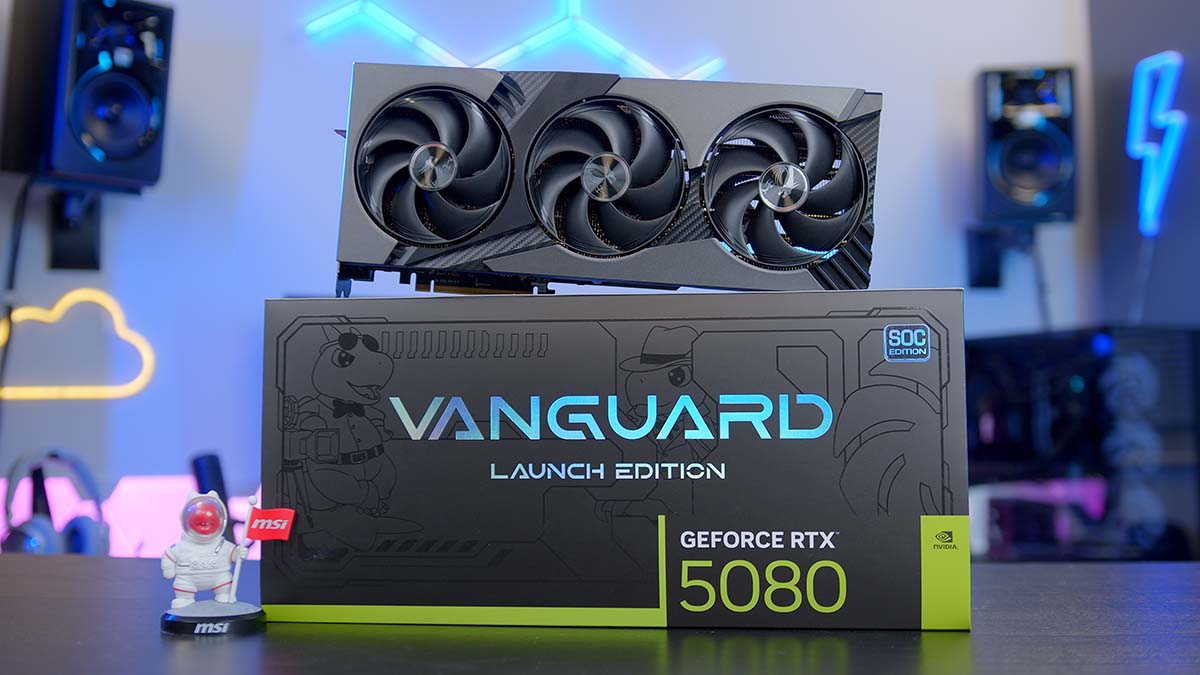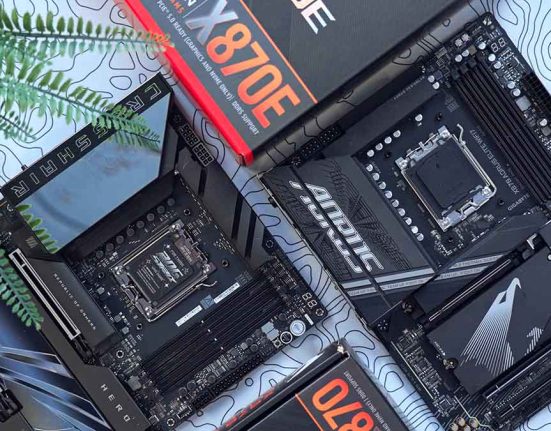The MSI RTX 5080 VANGUARD is a new addition to MSI’s existing product stack, sitting between the MSI Gaming X lineup and the more premium SUPRIM cards. Despite a somewhat rocky reception during initial reviews, followed by the vast majority of cards immediately selling out as soon as they hit the shelves. It’s clear that there’s a tremendous amount of interest in the RTX 5080, which indicates, hopefully, a positive outlook for the rest of the SKUs. However, this review looks at the MSI RTX 5080 VANGUARD in plenty of depth to determine whether this variant is worthwhile.
MSI’s VANGUARD is in a reasonably strong position concerning the wider market, balancing pricing, design and performance. The Gaming X range often sacrifices aesthetics for pricing, while the SUPRIM cards are a more premium and sophisticated offering with a more significant cost. VANGUARD GPUs sit right in the middle, offering buyers a great-looking and performing card that’s not as expensive as some other AIBs on the market.
In today’s article, we’ll examine the MSI RTX 5080 VANGUARD, exploring its specs, design, architecture, thermals, and performance. We’ll provide an overview of this card to determine whether it’s worth considering compared to other GPUs.
Specification
Despite the RTX 5080’s ridiculous current prices, one of its USPs is that it shares its MSRP with the RTX 4080 SUPER, which is $999.99. This is important because it automatically makes the RTX 5080 the next best option for those looking for an 80-class GPU. This means those looking to build a new gaming PC or are looking for an upgrade for 4K gaming should steer towards the RTX 5080 unless the previous generation is significantly cheaper.
For AIBs, however, this MSRP pricing somewhat goes out of the window. While there are AIB cards that come in around MSRP, the vast majority tend to be priced at $100-$300 more based on their increased clock speeds, design, and thermals. Unfortunately, the MSI RTX 5080 VANGUARD sits in this camp, priced, at the time of writing, at $1249.99. As James has discussed in a video on the GeekaWhat channel, the prices are turbulent for several different reasons, which means, hopefully, we’ll see cards like the MSI VANGUARD variant come down over time.

Looking at the rest of the specs, the RTX 5080 has a 16GB capacity utilising GDDR7 VRAM on top of a 256-bit memory bus. Regarding core counts, there are 10752 CUDA cores, 336 Tensor cores, and 88 RT cores. Overall, the RTX 5080 is relatively similar to its predecessor, the RTX 4080 SUPER; on paper, both cards are pretty close concerning hardware. The boost clock speed on the MSI VANGUARD is slightly higher than MSRP models, sitting at 2.74GHz instead of 2.61GHz, which brings some performance benefits in certain games and applications.
| Key Specs | RTX 5090 | RTX 5080 | RTX 4080 SUPER |
|---|---|---|---|
| Video Memory | 32GB GDDR7 | 16GB GDDR7 | 16GB GDDR6X |
| Memory Bus | 512-bit | 256-bit | 256-bit |
| Base Clock Speed | 2.29GHz | 2.29GHz | 2.29GHz |
| Boost Clock Speed | 2.55GHz | 2.61GHz | 2.55GHz |
| CUDA Cores | 21760 | 10752 | 10240 |
| RT Cores | 170 | 88 | 80 |
| Tensor Cores | 680 | 336 | 320 |
| Power Consumption | 575W | 360W | 320W |
| MSRP | $1999.99 | $999.99 | $999.99 |
As we’ve noted in previous reviews, the introduction of DLSS 4 has significantly improved AI TOPS performance, which powers the latest iteration of DLSS. NVIDIA said in its initial press conference announcing this generation of graphics cards that it would not have been possible without AI, which we’re seeing some returns on with DLSS and Frame Generation.
Design
One of the other strong qualities of this particular VANGUARD model is its design and aesthetic. As we alluded to in the introduction, the VANGUARD range sits between the Gaming X and SUPRIM cards in terms of pricing and design. It’s slightly more of a looker than the Gaming X cards but not as expensive as SUPRIM, which puts it in a unique position.

Looking at the aesthetic, this is a triple-fan model with a predominantly black shroud. The centre of each fan features MSI’s signature dragon logo. The front of the card has a slightly lighter contrasting grey, similar to the design on some of the MSI AMD models. A strip of RGB lighting spans the diagonal of the card, which can be customised with the MSI Center application or something like SignalRGB, which provides extra customisation that can be synced up with the rest of the components in your build.

As you can expect, with this being a triple-fan card, the MSI VANGUARD RTX 5080 is fairly large, at 357mm long. This means you’ll need to consider clearance issues beforehand, as the size of this graphics card will be a problem with smaller chassis. Fortunately, MSI provides a way to support and alleviate sag that is not too dissimilar from the TUF model.

Architecture
All the RTX 5000-series graphics cards sit on top of the Blackwell architecture created by NVIDIA. This new range offers some pretty significant technological advancements from NVIDIA, one being the jump to GDDR7, allowing the RTX 5080 to utilise the PCI-E 5.0 expansion slots that have been saturating the market over the past couple of years. Additionally, uplifts to AI TOPS performance have allowed NVIDIA to push DLSS even further, alleviating performance overhead while introducing a new form of Frame Generation, Multi Frame Generation.
In short, Multi Frame Generation is more aggressive than its original version. Instead of generating one frame between two rasterised frames, Multi Frame Generation provides three. So, for every rasterised frame, Multi Frame Generation offers three instead. Now, you’re probably thinking, is this free performance? The short answer is no. To explain it, Multi Frame Generation provides extra frames, making overall gameplay smoother and offering a better visual experience.

It doesn’t work the same way that DLSS does, as with DLSS, your graphics card can work harder due to having less performance overhead. While standard Frame Generation does offer some alleviation, Multi Frame Generation is, to a degree, providing what many reviewers have called ‘fake frames’. While I disagree with the name necessarily, the sentiment isn’t entirely incorrect. Multi Frame Generation offers a way to make your favourite games buttery smooth instead of increasing system performance.
It’s worth noting that there is a pretty significant caveat to Multi Frame Generation, and this is system latency. Switching on this tech adds perceivable latency to the games you’re playing. But in our experience and testing, it’s a bit of a mixed bag. In Hogwarts Legacy, for example, latency held around 2ms, which is relatively minimal and won’t significantly impact gameplay. However, in Cyberpunk 2077, latency averaged 16ms, a large enough slowdown to be noticeable and impact gameplay. This means it may be worth switching off Multi Frame Generation in more fast-paced gameplay that requires better reaction speeds.
Performance & Thermals
In this section, we’ll look at the gaming benchmarks and thermal performance of a selection of RTX 5080 models. We’ve tested the MSI VANGUARD and compared it against the Founders Edition and Palit GameRock OC variants of the RTX 5080 to see their major differences.
Cyberpunk 2077
Settings: 4K, Shadow Quality High, Indirect Lighting High, Reflections High, Crowd Density High, Particle Quality High, Volumetric Lighting High, Motion Blur off, GTAO Quality High, Grass Quality High, Contact Shadows High VSync Off, DLSS: On/Off, Ray Tracing: On/Off, Textures: High
Our first game was Cyberpunk 2077, in which we tested the RTX 5080 variants with DLSS and Ray Tracing enabled. In this run, the Palit GameRock OC variant came out on top with a 65FPS out, followed by the MSI VANGUARD at 64FPS. It’s no surprise to see the FE model at the bottom with a 62FPS average, but obviously, the difference compared to the Palit GameRock OC is minimal.
Temperatures-wise, MSI’s VANGUARD RTX 5080 beat the Palit GameRock OC and Founders Edition cards with a 59°C average. While the 63°C result on the Palit GameRock OC isn’t concerning, the MSI VANGUARD is proving to be a better option for those prioritising lower temperatures.

After switching on the controversial Multi Frame Gen setting, average FPS skyrocketed across the board, with the Palit GameRock OC coming out on top with 200FPS; the higher boost clock speed is definitely assisting performance. Temperatures remained similar across the board, with the Palit model dropping by 1°C. It’s interesting to see the difference boost speed makes here, as the FE model, which utilises the baseline specs, loses out by 10FPS.

Hogwarts Legacy
Settings: 4K Effects High, Material High, Fog High, Sky High, Foliage High, Post Process High, Shadows High, Textures High, View Distance High, Population High, Anti Aliasing TAA High, Windowed Fullscreen
In Hogwarts Legacy at 4K high, results across the cards in this benchmark are reasonably similar. Palit is a clear winner yet again with a 105FPS average, followed by the MSI VANGUARD at 103FPS and the Founders Edition card at 101FPS. Temperatures slightly improved in Hogwarts Legacy with the MSI VANGUARD RTX 5080 sitting at 57°C with Palit and NVIDIA at 61°C and 62°C, respectively. Again, MSI’s card is definitely a standout option when it comes to thermals.

Marvel Rivals
Settings: 4K, Graphics Quality High, Global Illumination Lumen GI- High Quality, Reflection Quality Screen Space Reflections, Model Detail High, Post-Processing High, Shadow Detail High, DLSS On/Off, Frame Gen On/Off
Firing up Marvel Rivals at 4K with Multi Frame Gen enabled, the Palit GameRock OC version of the RTX 5080 sits at the top of the graph with a 330FPS average. The Palit card was incredibly strong in this run, beating out the MSI VANGUARD model by 27FPS. Again, temperatures are perfectly fine here. The MSI VANGUARD GPU wins with a 56°C average, while the NVIDIA FE RTX 5080 sits at 58°C, coming up close behind.

COD Black Ops 6
Settings: 4K, Graphics Preset Custom, Texture Resolution High, Depth of Field On, Detail Quality High, Particle Resolution High, Shader Quality High, Shadow Quality High, Screen Space Shadows High, DLSS On/Off, Frame Gen On/Off
In our COD Black Ops 6 benchmark performance wasn’t as impressive. We don’t tend to use DLSS in this game because it doesn’t massively impact performance, so we decided to run a rasterised test. The Palit GameRock RTX 5080 OC leads the fore with a 117FPS average while temperatures remained at 52°C. The MSI VANGUARD RTX 5080 card sits at 53°C in this benchmarking run, slightly beating out the Founders Edition, but losing to the Palit GameRock OC model by a single degree. The Founders Edition, unfortunately, sits at the bottom of the graph with a 103FPS average, while temperatures hovered around 56°C.

Conclusion
MSI VANGUARD RTX 5080
-
Features
-
Design
-
Performance
-
Value For Money
Summary
The MSI VANGUARD RTX 5080 is one of the more interesting AIB models we’ve seen. As a new SKU slotting into MSI’s existing range of graphics cards, the VANGUARD strikes a delicate balance between pricing and design, offering a fanciful aesthetic while not being as expensive as the more premium SUPRIM cards. Additionally, this card is very thermally capable, consistently beating out other RTX 5080 variants. General gaming performance is also pretty strong, sitting above the FE cards but not quite aligning with the Palit GameRock OC.
However, compared to the broader market, I feel the MSI VANGUARD RTX 5080 is a harder sell. The main USP of the VANGUARD variant is thermals, and I think most buyers won’t be able to justify spending $200-$300 more for a slightly cooler build. The design is solid, but the MSI VANGUARD variant doesn’t look as strong compared to the Palit GameRock OC, which offers a highly unique aesthetic and vastly improved performance in certain games. If you’re prioritising temperatures, this card is worth considering, but only if you can pick it up for close to MSRP pricing.
Pros
✅ Solid thermals
✅ Great design
✅ Awesome RGB lighting
Cons
❌ Pricey
❌ Not as strong as Palit GameRock model
❌ Hard to find








![FI_[DM78] Corsair Air 5400 + 5090 Gaming PC Build](https://geekawhat.com/wp-content/uploads/2025/11/FI_DM78-Corsair-Air-5400-5090-Gaming-PC-Build-551x431.jpg)